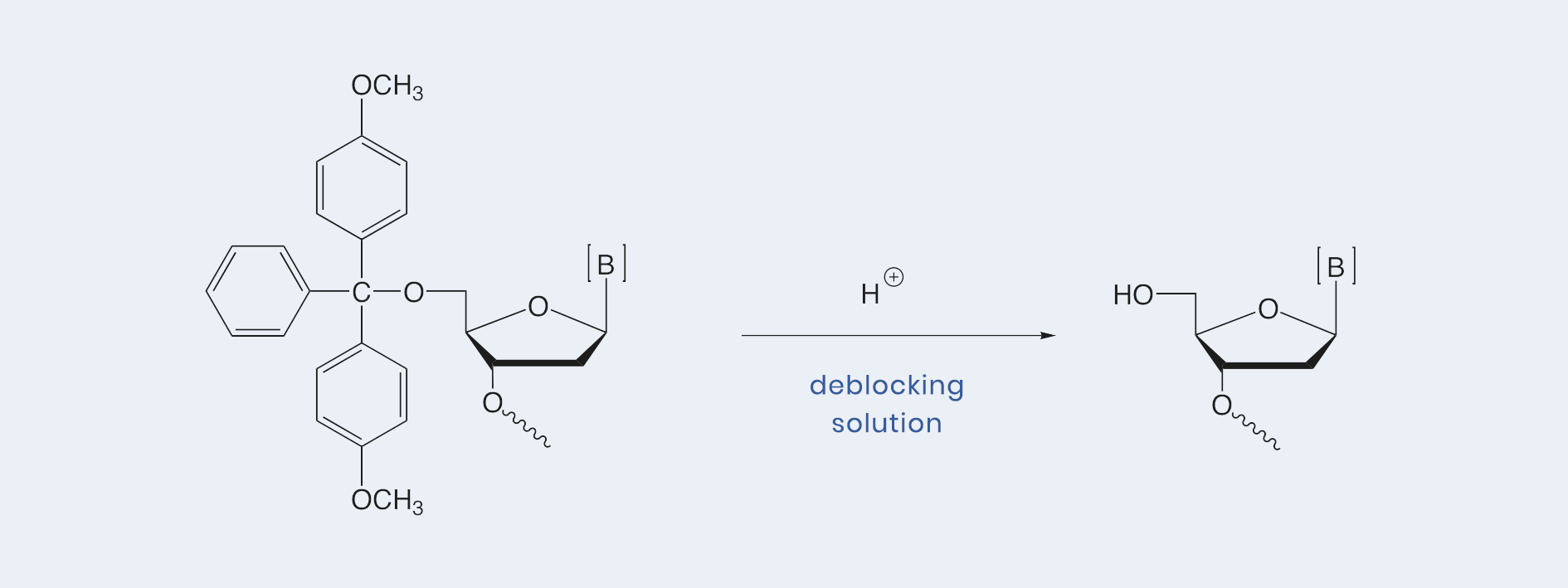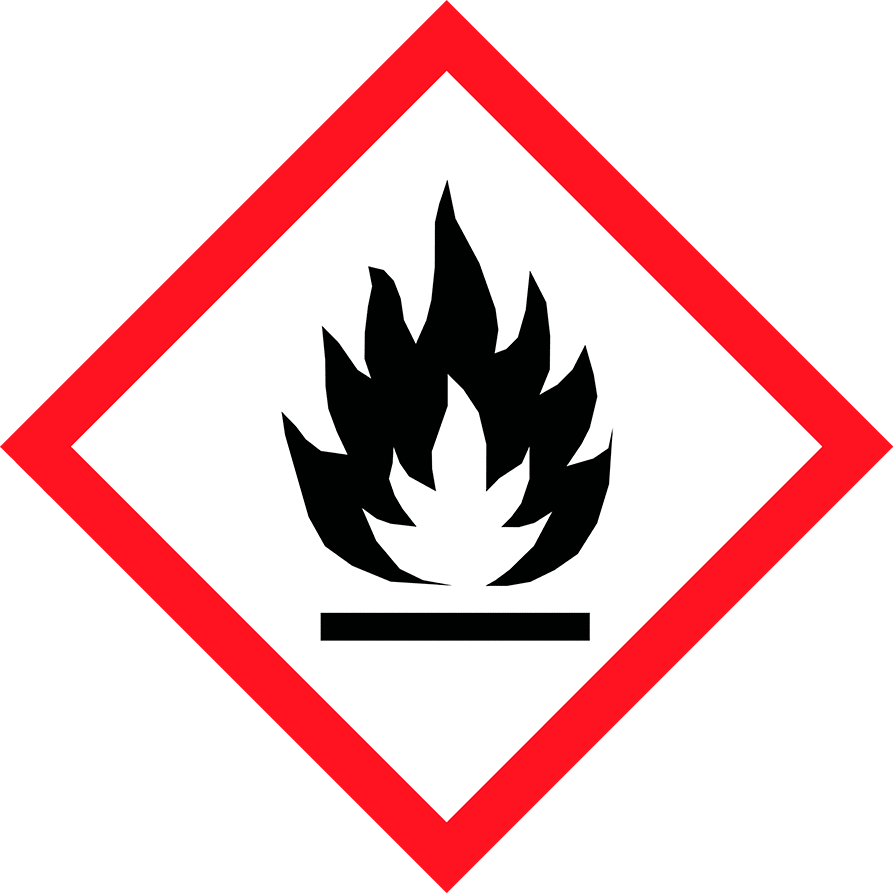
Bulk requests
This product is available in manufacturing scale (bulk) volumes and formulations.
Please use the button below to request information about bulk volume availability and customized formulations.
Send e-mail
Deblocking / Detritylation
 Deblocking solutions, used for the cleavage of the 5‘-DMTr group at the last building block of nucleotide chain, can consist either of dichloroacetic or trichloroacetic acid in dichloromethane or toluene. Our Hyacinth Deblocking solution (3 % dichloroacetic acid in toluene at < 30 ppm water) is applicable for the syntheses of high quality, large scale oligonucleotides.
Deblocking solutions, used for the cleavage of the 5‘-DMTr group at the last building block of nucleotide chain, can consist either of dichloroacetic or trichloroacetic acid in dichloromethane or toluene. Our Hyacinth Deblocking solution (3 % dichloroacetic acid in toluene at < 30 ppm water) is applicable for the syntheses of high quality, large scale oligonucleotides.





Hazard Classifications
Flammable liquid, Category 2 (Flam. Liq. 2)
Aspiration hazard, Category 1 (Asp. Tox. 1)
Skin irritation, Category 2 (Skin Irrit. 2)
Serious eye damage/eye irritation, Category 1 (Eye Dam. 1)
Specific target organ toxicity - single exposure, Category 3 (STOT SE 3)
Carcinogenicity, Category 2 (Carc. 2)
Reproductive toxicity, Category 1B (Repr. 1B)
Specific target organ toxicity - repeated exposure, Category 2 (STOT RE 2)
Hazardous to the aquatic environment, Category 3 (Aquatic Chronic 3)
Hazard Statements
| H225 | Highly flammable liquid and vapour. |
| H304 | May be fatal if swallowed and enters airways. |
| H315 | Causes skin irritation. |
| H318 | Causes serious eye damage. |
| H336 | May cause drowsiness or dizziness. |
| H351 | Suspected of causing cancer <state route of exposure if it is conclusively proven that no other routes of exposure cause the hazard>. |
| H360FD | May damage fertility. May damage the unborn child. |
| H373 | May cause damage to organs <or state all organs affected, if known> through prolonged or repeated exposure <state route of exposure if it is conclusively proven that no other routes of exposure cause the hazard>. |
| H410 | Very toxic to aquatic life with long lasting effects. |
Precautionairy Statements
| P210 | Keep away from heat, hot surfaces, sparks, open flames and other ignition sources. No smoking. |
| P273 | Avoid release to the environment. |
| P280 | Wear protective gloves/protective clothing/eye protection/face protection. |
| P301+P310 | IF SWALLOWED: Immediately call a POISON CENTER/doctor/…. |
| P305+P351+P338 | IF IN EYES: Rinse cautiously with water for several minutes. Remove contact lenses, if present and easy to do. Continue rinsing. |
| P331 | Do NOT induce vomiting. |
Signal Word
Danger
WGK
WGK 2
Storage Class Code
3 - Flammable liquids
ADR, RID (road and railroad)
UN2924 FLAMMABLE LIQUID, CORROSIVE, N.O.S. (Solution of Dichloroacetic Acid in Toluene), 3(8), II
IATA-DGR (transport by air)
UN2924 FLAMMABLE LIQUID, CORROSIVE, N.O.S. (Solution of Dichloroacetic Acid in Toluene), 3(8), II
IMDG-Code (transport by sea)
UN2924 FLAMMABLE LIQUID, CORROSIVE, N.O.S. (Solution of Dichloroacetic Acid in Toluene), 3(8), II





Gefahreneinstufungen
Entzündbare Flüssigkeiten, Kategorie 2 (Flam. Liq. 2)
Aspirationsgefahr, Kategorie 1 (Asp. Tox. 1)
Ätz-/Reizwirkung auf die Haut, Kategorie 2 (Skin Irrit. 2)
Schwere Augenschädigung/Augenreizung, Kategorie 1 (Eye Dam. 1)
Spezifische Zielorgan-Toxizität (einmalige Exposition), Kategorie 3 (STOT SE 3)
Karzinogenität, Kategorie 2 (Carc. 2)
Reproduktionstoxizität, Kategorie 1B (Repr. 1B)
Spezifische Zielorgan-Toxizität (wiederholte Exposition), Kategorie 2 (STOT RE 2)
Gewässergefährdend, Kategorie 3 (Aquatic Chronic 3)
Gefahrenhinweise - H-Sätze
| H225 | Flüssigkeit und Dampf leicht entzündbar. |
| H304 | Kann bei Verschlucken und Eindringen in die Atemwege tödlich sein. |
| H315 | Verursacht Hautreizungen. |
| H318 | Verursacht schwere Augenschäden |
| H336 | Kann Schläfrigkeit und Benommenheit verursachen. |
| H351 | Kann vermutlich Krebs erzeugen (Expositionsweg angeben, sofern schlüssig belegt ist, dass diese Gefahr bei keinem anderen Expositionsweg besteht). |
| H360FD | Kann die Fruchtbarkeit beeinträchtigen. Kann das Kind im Mutterleib schädigen. |
| H373 | Kann die Organe schädigen (alle betroffenen Organe nennen) bei längerer oder wiederholter Exposition (Expositionsweg angeben, wenn schlüssig belegt ist, dass diese Gefahr bei keinem anderen Expositionsweg besteht). |
| H410 | Sehr giftig für Wasserorganismen, mit langfristiger Wirkung. |
Sicherheitshinweise - P-Sätze
| P210 | Von Hitze, heißen Oberflächen, Funken, offenen Flammen und anderen Zündquellen fernhalten. Nicht rauchen. |
| P273 | Freisetzung in die Umwelt vermeiden. |
| P280 | Schutzhandschuhe/Schutzkleidung/Augenschutz/Gesichtsschutz/Gehörschutz/… tragen. |
| P301+P310 | BEI VERSCHLUCKEN: Sofort GIFTINFORMATIONSZENTRUM/Arzt/… anrufen. |
| P305+P351+P338 | BEI KONTAKT MIT DEN AUGEN: Einige Minuten lang behutsam mit Wasser spülen. Eventuell vorhandene Kontaktlinsen nach Möglichkeit entfernen. Weiter spülen. |
| P331 | KEIN Erbrechen herbeiführen. |
Signalwort
Gefahr
WGK
WGK 2
Lagerklasse
3 - Entzündliche flüssige Stoffe
ADR, RID (Strasse und Eisenbahn)
UN2924 FLAMMABLE LIQUID, CORROSIVE, N.O.S. (Solution of Dichloroacetic Acid in Toluene), 3(8), II
IATA-DGR (Luftverkehr)
UN2924 FLAMMABLE LIQUID, CORROSIVE, N.O.S. (Solution of Dichloroacetic Acid in Toluene), 3(8), II
IMDG (Seeschiffverkehr)
UN2924 FLAMMABLE LIQUID, CORROSIVE, N.O.S. (Solution of Dichloroacetic Acid in Toluene), 3(8), II
